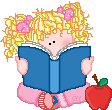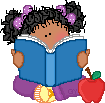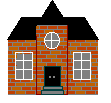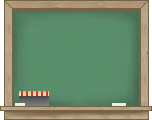 Annie's "Back to School Symbols" Page
Annie's "Back to School Symbols" Page 
 Annie's "Back to School Symbols" Page
Annie's "Back to School Symbols" Page 
"Train up a child in the way he
should go:
and when he is old, he will not depart from it."
~Proverbs 22:6~
"My
son, hear the instruction of thy father,
and forsake not the law of thy mother:"
~Proverbs 1:8~
"Only take heed to thyself, and
keep thy soul diligently, lest
thou forget the things which thine eyes have seen, and lest
they depart from thy heart all the days of thy life: but
teach them thy sons, and thy sons' sons;"
~Deuteronomy 4:9~
"And,
ye fathers, provoke not your children
to wrath: but bring them up in the
nurture and admonition of the Lord."
~Ephesians 6:4~
![]()
PRAYER IN SCHOOL
WRITTEN BY A 12
YEAR-OLD-GIRL in Boston

Now I sit me
down in school
Where praying is against the rule.
For this great nation under God
Finds mention of Him very odd.
If Scripture now the class recites
It violates the Bill of Rights.
Anytime my head I bow
Becomes a federal matter now.
The law is specific; the law is precise.
Praying out loud is no longer nice.
Praying aloud in a public hall
Upsets those who believe
in nothing at all.
In silence alone we can meditate
and if God should get the credit--great!
They are bringing their guns,
I don't dare bring my Bible,
To do so might make me liable.
So, now Oh Lord, this plea I make;
Should I be shot in school,
My soul please take.
Written by Chris

Many Christians send their children to "Christian
Schools" or "Homeschool" their children.
"Study to show thyself approved unto God a workman who needeth not to be ashamed."
Now that we have the computer it is much easier to do research and projects for families and students.
The World Book says this about Home
Schooling:
Home
schooling is a form of education in which most of a child's
instruction is conducted in the home. An estimated 600,000 to
more than 1 million children in the United States are educated at
home. Parents are usually the main teachers. Families who educate
their children at home typically give lessons in subjects similar
to those in public and private schools.
There are many reasons parents choose home schooling for their
children. Most parents do so because they want to teach a
specific set of values, usually Christian, to their children.
Parents may also decide on home schooling because they cannot
afford to send their children to a private school. Others may
want less structured learning for their children than a typical
public or private school provides. Some may want greater control
over the selection of material their children are being taught.
Some families organize home schools like a conventional school,
with structured daily activities. Others view all of life as an
opportunity for learning and use a very flexible schedule. Most
families provide educational experiences outside as well as
inside the home. Their children may visit museums, work in a
garden, or serve apprenticeships. Some home-school families use
textbooks and prepackaged courses of study. Other home school
families create their own materials.
Critics
of home education say that home-schooled children may not have
enough contact with other children, especially those from
different backgrounds. Critics also say that the average parent
is not as qualified as a schoolteacher to educate a child.
Studies show, however, that most home-schooled children achieve
scores equal to or better than public-school students in college
entrance examinations, achievement tests, and social development
tests.
Since the late 1970's, increasing numbers of parents in the
United States have begun to teach their children at home. Each
state has different laws to govern the operation of home schools.
Some parents teach their children at home instead of sending them to a regular school. This arrangement is called home schooling. However, the children must receive an education equal to that of public school students. A state or province may test children educated at home to see that they meet standards for students who attend public schools.
Education is the process by which people acquire knowledge, skills, habits, values, or attitudes. The word education is also used to describe the results of the educational process. Education should help people become useful members of society. It should also help them develop an appreciation of their cultural heritage and live more satisfying lives. The most common way to get an education is to attend school. But much education also takes place outside the classroom.

Education
involves both learning and teaching. Sometimes, people learn by
teaching themselves. But they also learn with the help of other
people, such as parents or teachers. Parents are a child's first
and perhaps most important teachers. They teach their children
attitudes, habits, and values that help shape their character and
remain with them throughout life. But few parents have either the
time or the ability to teach their children everything they need
to know. Instead, they turn over many educational
responsibilities to professional educators.
![]()
NEW - 8/13/01 - Received an email that drew attention to this sentence above: "A state or province may test children educated at home to see that they meet standards for students who attend public schools." She mentions that: "The state may not force us to test, in Texas anyway! Check out the: Home School Legal Defense Association
![]()
The organization of U.S. education

Formal
education in the United States is divided into various stages or
levels that follow one another somewhat like the rungs of a
ladder. Pre-elementary education is the first rung of the
educational ladder. It is followed by elementary education,
secondary education, and higher education. Ordinarily, students
complete one stage before they continue to the next.
School attendance is compulsory (required) in every state. Thirty-two states require attendance through age 16, nine states and the District of Columbia through age 17, eight states through age 18, and one state through age 14. Many states make exceptions to the age requirements. In 17 states, for example, students fulfill the attendance requirements when they graduate from high school, even though they may not have reached the required age. In 16 states, completion of the eighth grade fulfills the requirements under certain conditions.
![]()
Let's learn about the PENCIL with
the help of The Compton's Encyclopedia........

PENCIL - A thin rod of a solid
marking material, such as graphite, enclosed in a cylinder of
wood, metal, or plastic is a pencil. The word comes from the
Latin penicillium, which means "little tail," and
refers to a small brush used by the Romans as a writing
implement.
It is a popular implement for writing, drawing, or marking. In the United States alone, consumers purchase more than 2 1/2 billion pencils a year.
![]()
Why is a "number" designated to a pencil?
The
hardness of a writing pencil is designated by a number from 1,
the softest, to 4, the hardest. Artists' drawing pencils range
from the softest, 8B, to the hardest, F. The designation for
drafting pencils is from HB, the softest, to 10H, the hardest.
![]()
How did pencils get a covering?
The
familiar wooden casing for the pencil lead was perfected by
William Monroe, a cabinetmaker in the United States. When the War
of 1812 stopped the import of pencils to the United States from
Great Britain, American manufacturers had to make pencil leads
from inferior graphite, which broke easily. Monroe developed a
wooden pencil casing that enclosed the pencil lead, supporting
and protecting it.
![]()
Is lead inside a pencil?
Though
people refer to "lead" pencils, a pencil actually
contains no lead. Lead was used by the ancient Greeks and Romans
for marking or for drawing lines. It is in this sense that the
word is still used. The writing substance in a pencil is a
combination of graphite and a special puttylike clay. Graphite is
a compound that was given the name black lead when it was
discovered in the 1400s. In 1779 graphite was shown to be a form
of carbon.
![]()
The History of the Pencil:
The
development of the modern lead pencil began in 1564, when an
unusually pure deposit of graphite was discovered in Borrowdale
Valley in northern England. This English graphite could be cut
into rods and used without further manufacture. The rods were
wrapped with string or held in wooden casings.
When the Borrowdale deposit ran out, pencil makers were forced to use graphite of lower purity. This graphite had to be pulverized and mixed with a binder. Many types of binders were used, but it was not until 1795 that French chemist Nicolas-Jacques Conte discovered a successful formula. He blended powdered graphite with clay, resins, and a few other chemicals and fired the mixture in a kiln. The result was a new type of durable pencil lead.

The Crayon
Crayon, is a drawing implement made of clay, chalk, plumbago, dry
color, and wax; coloring crayon (also called wax crayon) is made
of waxes and dry color; chalk crayon is the chalk used on
blackboards.

Who started Finger Painting?
Modern
finger painting was developed by Ruth Faison Shaw, who conducted
a school for American and English children in Rome, Italy, from
1922 to 1932. She had become dissatisfied with the crude,
imitative pictures that children make with pencils, crayons, and
brushes. One day she sent a pupil with a scratched finger to the
bathroom for some iodine. When he did not return, she
investigated and found him, she said, "blissfully absorbed
in decorating the bathroom door with a finger dipped in
iodine." The incident gave her the idea of letting children
smear paint on paper with their fingers.
What are the 3 R's?

READING - The ability to see and
understand written or printed language is called reading. People
who cannot read are said to be illiterate, or unlettered.
WRITING - The history and prehistory of writing are as long as the history of civilization itself. Indeed the development of communication by writing was a basic step in the advance of civilization
ARITHMETIC - The foundation of all other branches of mathematics is arithmetic, the science of calculating with numbers. Without the ability to use numbers, it would not be possible to measure distance or tell time.
![]()
The history of GLUE
Natural
adhesives have been in use since ancient times, particularly
animal glue, casein glue, and adhesives made from plant resins.
Beeswax and pitch were used as adhesives for centuries. Some
3,300 years ago, the ancient Egyptians used animal glue to build
furniture, covering it with fine ornamental wood veneers and
ivory. Such furniture has been found in ancient tombs, the glue
still holding after all of that time. The Egyptians also used
adhesives for other purposes. Papyrus, which was used before
paper was invented, was made with a flour paste. Eggs, gum
arabic, and other plant resins were used as binders for paints.
In the Middle Ages, egg white was used to glue gold leaf to
parchment for illuminated manuscripts.
The adhesives known to the ancients were largely unchanged by later craftsmen until the 19th century, when rubber cements and pyroxylin cements (made from nitrocellulose) were introduced. The development of synthetic adhesives in the 20th century resulted in a wide variety of new types of adhesives, made for almost every purpose.
What do all the schools in the
United States have in common?

Regardless of
the structures of school systems, they have features in common.
There are four levels of schooling: preschool and kindergarten,
elementary, secondary, and college and university. The levels
themselves may be designated differently, but they are
consistently similar nevertheless. Another common feature is
compulsory schooling for children from ages 5 or 6 through the
middle teen years.

The School Year & Information in different countries:
UNITED STATES - Although the United States Cabinet has a Department of Education, it has no authority over the operation of schools. The responsibility for education rests with the states in cooperation with local school districts. There are about 30,000 such districts, and each runs its own schools and raises its own taxes.
AUSTRALIA - The school year extends from late January or early February into mid-December. Students attend class for about 120 days per year. Literacy stands at 99.5 percent of the population. The summer months are December through February. Australia has three standard time zones.
Australian children are required to attend school between the ages of 6 and 15 or 16. Ninety percent of them attend government-operated primary schools, but 30 percent attend non-government secondary schools. Government schools are usually coeducational, whereas the custom in private school has been single-sex. About 60 percent of all pupils complete high school. But this figure is somewhat misleading since it includes a range from 50 percent for boys in government schools to 80 percent for girls in non-government schools.
CANADA - The Canadian school system is decentralized but not to the extent that it is in the United States. By the British North America Act of 1867, the provinces were given authority to direct the schools within their borders. There is no ministry of education at the national level, but each province has its own minister, who remains in office as long as his party is in power. The official who actually governs the operation of the schools is the deputy minister, who remains at the post regardless of party changes.
NEW ZEALAND - Schooling in New Zealand is free and compulsory between the ages of 6 and 16, but most children start school at 5 years. Many children attend preschool classes. In addition to public and private schools, home education is also allowed. In remote areas, children are taught by a correspondence school method.
SCOTLAND - Education in Scotland is free in publicly maintained state schools from nursery school (3 to 5 years) through secondary school. At about 11 years of age primary school students enter secondary schools. Students may legally leave school at 16. Students who earn a certificate can continue to the professional schools and the universities.
GREECE - Education is required and free until the age of 15. After attending primary school for six years, children go to a "gymnasium" for three years and then may attend a lyceum for college preparatory work after passing the necessary examinations. After four years at a lyceum, students may take examinations for admission to a university or technical college.
KOREA - In South Korea, elementary education is compulsory for children 6 to 11 years of age. Secondary education is provided in middle schools for 12- to 14-year-olds and in academic and vocational high schools for 15- to 18-year-olds. Higher education is offered in two- and four-year colleges and universities.
JAPAN - Authority for running the school system in Japan exists at three levels: national, prefecture, and local. (Japan is divided into 47 prefectures, comparable to provinces or states.) The modern school system was introduced in 1868. Elementary and secondary schools were set up throughout the country by 1872. Free compulsory education began in 1900. Today the compulsory period is nine years, beginning at age 6.
Preschool, which lasts from one to three years, is not compulsory. This is followed by elementary school for six years, middle school for three years, and high school for three years. High school is not compulsory, but nearly everyone attends. Higher education includes junior colleges, four-year colleges, and universities. There is a system of rigorous annual examinations to determine which college or university a high school student may enter. Competition for placement in institutions of higher learning is intense.
Because Japan does not have a strong tradition of local government, actual direction of the school system has devolved on the prefectures and the national Ministry of Education. The ministry drafts all laws on national educational standards and allots a great deal of financial aid to local districts. Local school boards are legally responsible for running elementary and lower secondary schools. The prefectures manage the upper secondary schools, special schools, teacher certification, and textbook selection. Prefectural boards are appointed.
FRANCE - About 15 percent of French elementary schoolchildren and 20 percent of those at secondary levels go to church schools. Education is free in both the public schools and universities of France.
A
typical French student begins preschool activities as early as
the age of 2 and enters elementary school at 6. After five or six
years of the first educational cycle, called preparatory,
elementary, or middle courses, the student enters college (high
school) for an additional four years. During the final year of
this pro- gram, students of 15 or 16 are directed to the second
cycle, which offers three years at a lycee (secondary school), or
various technical and vocational courses. This is a controversial
part of the French system be- cause of the young age at which
career decisions must be made and because children of workers and
farmers appear to have fewer opportunities to attend a lycee.
~All above information From Compton's Encyclopedia~
Return to Annie's "Back to School" Page
Annie's
Featured Holiday Page |
Annie's
Featured Page |
Copyright
2000 - 2006 Annie's Home Page. All Rights Reserved. I thank the
Lord for graphics artists without them these pages would not be
the same.
Please visit Annie's List of Great
Graphics Spots for a list of their links.
Some Graphics on this page from: Country Tidbits Graphics & Cute Colors
& Graphic Garden & Lori's Country
Graphics. This site hosted by:
Christian Web Host. Silent
No Right Click Script from Dynamic Drive.
For Instructions visit: Annie's "How to Add
Silent No Right Click Script" Page